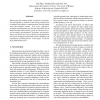Free Online Productivity Tools
i2Speak
i2Symbol
i2OCR
iTex2Img
iWeb2Print
iWeb2Shot
i2Type
iPdf2Split
iPdf2Merge
i2Bopomofo
i2Arabic
i2Style
i2Image
i2PDF
iLatex2Rtf
Sci2ools
IEEEICCI
2006
IEEE
2006
IEEE
User-centered Interactive Data Mining
While many data mining models concentrate on automation and efficiency, interactive data mining models focus on adaptive and effective communications between human users and computer systems. User views, preferences, strategies and judgements play the most important roles in human-machine interactivities, guide the selection of target knowledge representations, operations, and measurements. Practically, user views, preferences and judgements also decide strategies of abnormal situation handling, and explanations of mined patterns. In this paper, we discuss these fundamental issues.
| Added | 11 Jun 2010 |
| Updated | 11 Jun 2010 |
| Type | Conference |
| Year | 2006 |
| Where | IEEEICCI |
| Authors | Yan Zhao, Yaohua Chen, Yiyu Yao |
Comments (0)

